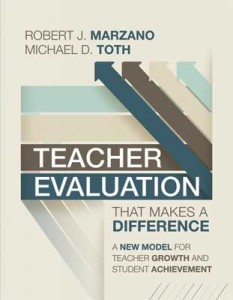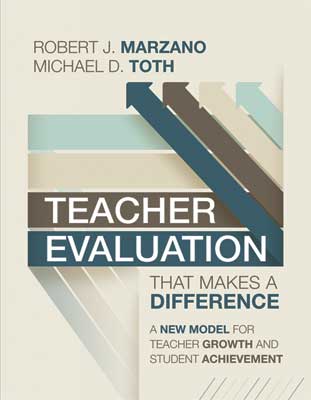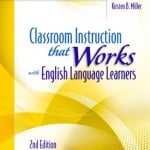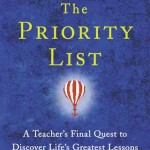Teacher Evaluation That Makes a Difference: A New Model for Teacher Growth and Student Achievement
By: Robert J. Marzano and Michael D. Toth
Published by ASCD, 2013
[fusion_builder_container hundred_percent=”yes” overflow=”visible”][fusion_builder_row][fusion_builder_column type=”1_1″ background_position=”left top” background_color=”” border_size=”” border_color=”” border_style=”solid” spacing=”yes” background_image=”” background_repeat=”no-repeat” padding=”” margin_top=”0px” margin_bottom=”0px” class=”” id=”” animation_type=”” animation_speed=”0.3″ animation_direction=”left” hide_on_mobile=”no” center_content=”no” min_height=”none”]
In the last few years, educators have been faced with the daunting prospect of having their professional futures linked to their students’ test scores. The best way to avoid an outcome like this is to create authentic evaluations ourselves. Robert J. Marzano and Michael D. Toth propose how to do this in their new book, Teacher Evaluation That Makes a Difference: A New Model for Teacher Growth and Student Achievement. It can only help us as professionals and experts in our field to engage in more meaningful evaluations that measure the quality of our work as well as the success of our students.
As teachers, we know that the industrial model of education that insists one-size-fits-all does our students no good. The same is true of teachers. As Marzano and Toth note, that one-size-fits-all has also been used historically in teacher evaluations, where the assumption is that measuring classroom effectiveness is the same from teacher to teacher. However, this assumption disrespects educators and it sells short a profession that has the ability to measure a variety of skills and talents. One truth supersedes all discussion about evaluations: research consistently shows that the individual teacher has a powerful effect on the learning of his or her students. Because of this, providing a framework for evaluating and helping teachers increase their professionalism can only make the students’ experience more positive.
This book is based on intensive research and testing. The authors address all the various aspects of evaluation that must be improved around the country. They make six major recommendations for accomplishing this change:
First, they suggest that student growth should be “measured in multiple ways and aggregated across multiple measures.” This is a crucial starting point because a robust form of measurement of student success can outweigh the pressure of high-stakes testing that is corrupting the creative and versatile nature of true education. We teachers have to push back against the growing political obsession with testing by offering a common-sense and thorough alternative. This book does just that, with detailed evidence and suggestions on how to incorporate value added measures for student assessment, as well as longitudinal or vertical assessment to measure authentic student growth. Providing direction on how to use multiple measures in student growth, the authors provide teachers with a strong and stable first step to re-creating an evaluation system that serves both the students and the profession itself.
Second, Marzano and Toth recommend that data about teachers’ classroom practices should come from multiple sources over multiple points in time. We can all relate to the frustration of having two, maybe three, “formal observations” during a year, and rarely seeing an administrator otherwise. Basing a judgment on quality teaching on such scarce and inauthentic evaluation does none of us any good. Teacher evaluations need to be used both for measurement and development; therefore, they need to be frequent, varied and offer authentic feedback and data. Planned observations are important for certain factors, just as short, focused informal observations can measure other issues. In addition, walkthrough observations by colleagues, and even video observations interspersed regularly throughout the year are ways to make observation data more robust and geared toward each specific teacher’s needs and development. In addition, non-observation strategies can also really enhance the evaluation. These can include teacher tests, student surveys, pedagogical writing or reflection, etc.
Third, the authors suggest that teachers’ behaviors outside the classroom should also be a part of an authentic evaluation. Teachers do more than just show up and teach within the four walls of their classroom. There is a tremendous amount of preparation and planning that goes into that classroom time, and reflection that occurs afterwards. Giving teachers credit for preparation and reflection that enhance classroom teaching is also a valuable part of evaluating quality.
The authors go on to note that teacher evaluations need to show true distribution of abilities among teachers. Again, this is moving away from the one-size-fits-all model of measuring professional skills. A system that simply hands out the highest scores to all the teachers all the time does not enhance the teachers’ professionalism, nor does it serve the students and community. There is no reason why teachers should not be able to work within a new kind of system that takes into account their individual backgrounds, skills, progress and work throughout the school year. In addition, the authors note that effective evaluations should also be the basis for authentic support for teachers. It should be the district’s job, and is in within the district’s and administration’s best interest, to provide teachers with the pedagogical and skill support they need to improve their professionalism.
Finally, evaluations should be hierarchical, according to the authors. There is no reason why the focus need only be on teachers. Teachers are not solely responsible for what occurs in a school or district, they are influenced and affected by their administrators and district leadership. Evaluations of those leaders based on the support they provide teachers is also a crucial aspect of improving the professionalism of all educators so that students can enjoy the best of what their school can offer.
As educators, we know we have to be the ones to initiate true change within our profession or those who have no true expertise in our career field will change it for us. Authentic evaluations and finding ways to improve our professionalism are the first in a series of steps we must take to begin this evolution in our education system. The strong, research-based recommendations in Teacher Evaluation That Makes a Difference are a great place to start. I highly recommend this to all educators seeking to enhance their professional lives.
Disclaimer: This book was provided to The Educator’s Room free of charge by the publisher. However, neither The Educator’s Room nor the reviewer received any compensation for this review. The opinions contained in this review are those of the reviewer alone and were written free of any obligation or agreement with the publisher. If you have any questions regarding book reviews, see our full disclaimer or contact the Book Review Editor.[/fusion_builder_column][/fusion_builder_row][/fusion_builder_container]





